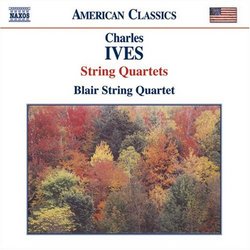| All Artists: Charles Ives Title: Ives: String Quartets Members Wishing: 0 Total Copies: 0 Label: Naxos American Original Release Date: 1/1/2006 Re-Release Date: 10/31/2006 Genre: Classical Styles: Chamber Music, Historical Periods, Classical (c.1770-1830), Modern, 20th, & 21st Century Number of Discs: 1 SwapaCD Credits: 1 UPC: 636943917824 |
Search - Charles Ives :: Ives: String Quartets
 | Charles Ives Ives: String Quartets Genre: Classical
|
Larger Image |
CD DetailsSimilar CDs
|
CD ReviewsIves's String Quartets on Naxos Robin Friedman | Washington, D.C. United States | 02/21/2007 (5 out of 5 stars) "This review is in memory of Bob Zeidler who shared his learning and enthusiasm for the music of Charles Ives in many reviews on this site. With this CD in its American Classics series, Naxos continues its presentation of the music of the great American composer Charles Ives (1874 -- 1954) on budget-priced recordings. The previous six Naxos releases have included three of the four Ives symphonies, the complete violin sonatas, the "Concord" sonata for piano, a CD of chamber music, and various overtures and short pieces. This, the seventh Naxos CD devoted to Ives, includes the composer's two string quartets and a short scherzo performed by the Blair String Quartet, a deservedly acclaimed ensemble which serves as quartet-in-residence at the Blair School of music at Vanderbilt University. It is a worthy addition to the series and a good way for the listener to continue to hear the music of Ives. Ives's two string quartets were written at different times of his life and illustrate two of his major styles. The first quartet is an accessible flowing work full of Americana in the style that Aaron Copland would make famous half a century after this quartet. The second work is challenging and dissonant, brimming with ideas The works share in common Ives's goals of combining European and American themes in his music and, more important, Ives' attempt to convey in his music a feeling of religious awe and transcendence. Ives composed his first quartet, "From the Salvation Army" in 1896 while he was a student at Yale under Horatio Parker. But this is not a student work, Parker's strictures notwithstanding. It reminds me a great deal of the music of Dvorak. The first quartet is a lyrical work in which Ives captures the spirit of the American revival movement and of the hymns which he loved. The four movements, of nearly equal length, are in general quiet, subdued and flowing with a sense of unity derived from shared motifs and from quotations from gospel songs and hymns. The opening movement of the work is a fugue which Ives derived from an earlier composition for organ. Ives also used this movement again as the third movement of his fourth symphony. This opening movement, and the quartet as a whole is simple, immediately endearing music in the spirit of American paastorale. The second movement opens with the hymn "Bringing in the Sheaves" and works to a climax with the hymn returning again quietly at the end. The adagio continues the slow, songlike character of the quartet and features duets between the violin and the cello. After some changes in tempo, the movement returns to a quiet close. The finale is a joyous march with solo passages for each voice that leads to a triumphal conclusion for the entire ensemble. Ives's first quartet did not receive its first public performance until 1957 with the first movement omitted -- Ives had taken it out to use as the third movement of his fourth symphony. Only in 1961 was this quartet restored and performed in its entirety. It is a joy to have. Ives's second quartet was composed in 1911-13. It is a dense demanding work which, as does its predecessor, makes ample use of musical quotation but frequently in disguised or fragmented form. This work too has a programme which Ives described as "four men -who converse, discuss, argue... fight, shake hands, shut up -- then walk up the mountainside to view the firmament." The work consists of two lengthy outer movements surrounding a short middle movement. The movements are captioned "Discussions", "Arguments", and "The Call of the Mountains". The ending of the work is among Ives's most visionary utterances. The opening movement, "Discussions" is slow, gnarled and dissonant as the four voices converse in a frequently agitated manner. Near the end of the movement a strain of "Dixie" arises, among many other songs in what leads to an increasingly passionate discussion. The movement ends with dissonant broad chords and a quiet, pleading answer. In the short second movement, "Arguments", the four voices continue to quarrel gruffly as the violin attempts to sing a solo line which is drowned out by its companions. As the movement progresses, strains of "Britannia, Gem of the Ocean" are juxtaposed against Beethoven's Ode to Joy and snatches of Tchaikovosky and Brahms. The finale, the "Call of the Mountains" opens slowly and dissonantly in the lower strings. In the course of the movement, the dissonances become less harsh as the instruments talk together rather than argue. The cello plays a slow walking theme and -- after a large tremolo -- Ives ends his quartet with one of the most transcendentally suggestive passages in his music. The instruments speak slowly and reflectively to each other as the cello continues its meditations accompanied by passages of filigree and commentary in the highest register of the violin. The music soars before reaching a peaceful close. It is music worthy of the great American transcendentalists, Emerson and Thoreau, and of Ives's own Concord Sonata. Naxos continues to do a service by making the music of this great American composer available in textually correct beautifully performed readings. Robin Friedman" A foreign in his own country ! Hiram Gomez Pardo | Valencia, Venezuela | 01/19/2009 (4 out of 5 stars) "Around the figure of Charles Ives, the lately renown American composer, and still overlooked by many audiences, basically due his symphonic works, there's a debt of honor around him.
No other American composer had achieved such level in the genre of string quartet. With barely 21 years old, he adventured to compose his first string quartet, while the second one would be made between 1907 and 1913. The fact these works had not been performed until 1957 (sixty years after) gives a clear idea of the cold indifference of the American audiences about the egregious merits of this notable composer. In the first one you may realize three basic musical influences. Felix Mendelssohn, Max Reger and Arthur Sullivan which is to say the European Romantic and Post Romanticism roots. The second one differs totally of its forerunner, because reminds us to dissonant textures are laudatory, densely polytonal (if not atonal) rich in tensions, in which the second violin seems to embody the main enemy of the modern music, which refuges itself in the happiest repertoire, impugned by the other tree protagonist instruments. In particular, the version of the Julliard string quartet is by far the most vibrant hitherto that I have listened, after having compared it with other no less remarkable. That's why I can't give this particular recording five stars. It's well performed but lacks of that febrile poetry of the Julliard. " |

 Track Listings (8) - Disc #1
Track Listings (8) - Disc #1
